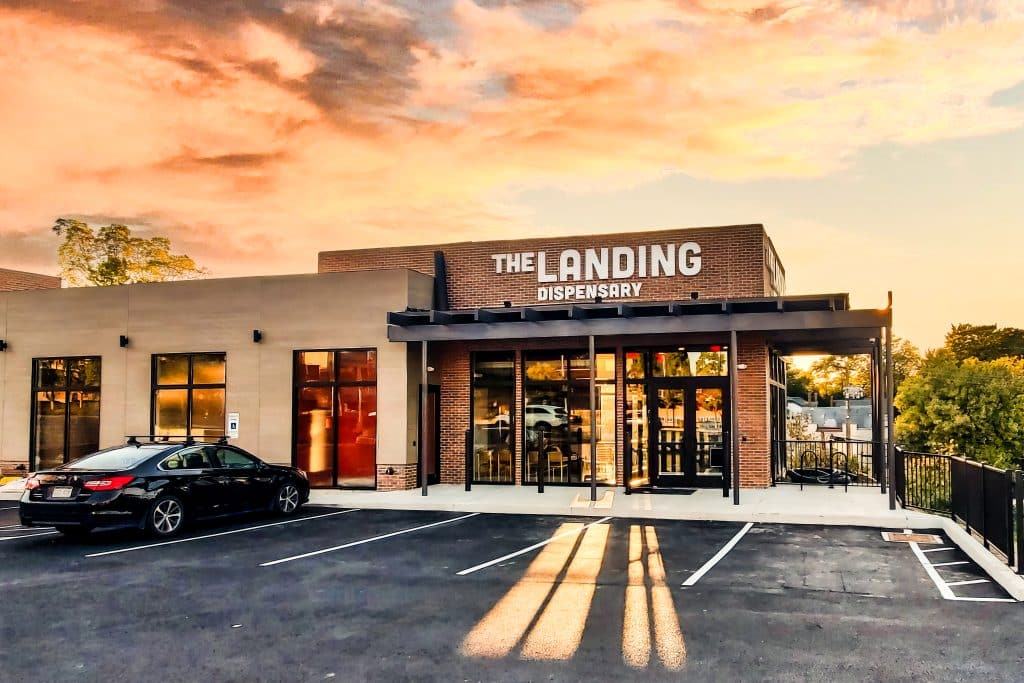There is no set date for the sales launch, but state operators and policymakers say they are ready to serve the expanded market.

Every day, patient care representatives at The Landing Dispensary’s five Ohio locations – including their storefront in Cleveland’s Tremont neighborhood – have customers arrive to their facilities, ready to purchase products, unaware that they still need a medical card to buy cannabis in the state.
Ohio voters ushered in adult-use cannabis legalization Nov. 7, 2023, and the initiated statute has been effective since Dec. 7, which made possession and home grows legal in the state.
But Jeff McCourt, CEO and founder of Firelands Scientific, a cannabis cultivator, as well as processor and parent company of The Landing Dispensary, said many are confusing that with commercial sales, which takes time to implement. Sales for non-medical cannabis have not yet launched.
“People show up at the store, and they don’t realize they needed to renew [their medical recommendation and registration] because they thought [adult-use legalization] passed in November,” McCourt said. “We’re losing patients month over month at a pretty dramatic clip.”
As of Feb. 29, there were about 14,500 fewer registered patients in the program since Oct. 31, 2023, just before the ballot measure Issue 2 passed, according to data from the Ohio Department of Commerce, which oversees the newly established Division of Cannabis Control (DCC). McCourt, who also founded the trade group Ohio Cannabis Coalition, says the program is losing about 5,000 patients each month.
That’s one reason why the DCC is working to “ensure legal sales begin as soon as possible under the process laid out by the initiated statute,” said Jamie Crawford, spokesperson for the DCC, via email.
“The DeWine administration has endorsed a legislative proposal to allow medical marijuana dispensaries to sell non-medical cannabis as soon as the legislation can become effective,” he said.
The other reason is to combat the illicit market, which has taken hold in other states where there is a long delay between legalization and the launch of adult-use sales. New York City is one of the most infamous examples, where unlicensed stores have flourished as the state has struggled to roll out more licensed dispensaries.
Although the statute includes a timeline for adult-use licensing applications to be available and a goal for when those will be awarded, there isn’t a set date for exactly when sales will launch.
That leaves cannabis operators in a hurry-up-and-wait situation, where they must be prepared for the increased demand that they aren’t quite sure when is coming. But operators say that despite this limbo period, they are ready, and this comes with the territory when expanding a cannabis market from medical to adult use.
According to DCC officials, consumers may be able to purchase adult-use cannabis in Ohio by the fall, as detailed in Issue 2, which voters approved by a 57% margin. However, according to reporting from News 5 Cleveland, Rep. Jamie Callender (R-Concord), told the outlet that sales could launch as soon as June.

The stated deadline for initial license applications to be available is June 7, 2024, and medical cannabis companies already operating in the program should be able to receive license approval —known as a “dual-use” license—quickly, Crawford said.
“We anticipate a streamlined application process for the conversion of current medical marijuana facilities to dual-use. If applicants are not making any changes to their ownership structure or modifying their facilities prior to beginning adult use sales, then it should be a relatively quick licensing process,” Crawford said. “One of the main reasons this process should be relatively quick for existing permit holders who want to be dual-use is because they have already gone through the stringent process that is already in place in order to acquire a medical use license.”
According to the statute, the DCC’s goal date to issue provisional licenses for non-medical facilities is Sept. 7, with the rules and regulatory framework for a new adult-use market in place.
“Sales of non-medical cannabis cannot happen until licenses are issued and facilities are certified,” Crawford said.
DCC has published drafts of proposed rules and elicited stakeholder feedback. The most recent version was made public April 3. So far, Crawford says the agency is on track, but there are factors that could cause setbacks. And because the ballot initiative was a statutory measure and not a constitutional amendment, the state legislature can amend it at any time, which could delay rulemaking, licensing and ultimately, sales.
However, Callender, who chairs The Joint Committee On Agency Rule Review (JCARR), told News Cleveland 5 that the agency plans to accept the proposed regulations for dual-use licenses from the DCC at its next meeting, May 13, which means medical operators already serving Ohioans would be able to get an adult-use license and open up sales as soon as a week after the applications open June 7.
Crawford said the DCC could not comment on an expedited timeline, as that would be determined by legislative and not regulatory action, but that they are following the voter-initiated statute.
“Anything that holds up the process – like delays in rulemaking or a lawsuit – could delay those deadlines, but the division is always working with stakeholders and doing everything possible at this point to meet the deadlines as laid out in the initiated statute approved by voters,” Crawford said. “There is confusion on why non-medical sales haven’t happened yet, but the way the initiated statute was written requires a rules-making process, and an application process that takes time.”
Stakeholder concerns
While Crawford emphasized that public health, safety, business security and efficiency remain the top priorities for the DCC in its rollout of an adult-use program, they’ve addressed feedback from cannabis cultivation and dispensary business owners and other stakeholders in the state, as well. Access is one issue that comes up a lot.
Until an adult-use program is in place, one way the DCC is trying to improve access and encourage patients to renew their registrations (or initiate one) is by reducing the card fee to just 1 cent. However, that does not account for the fee certified physicians charge for a medical marijuana recommendation, which varies, but is generally less than $100. Both must be renewed annually.
Since Ohio’s medical cannabis program launched five years ago, there have been more than 419,630 registered patients. As of Feb. 29, 167,431 patients had both an active registration and recommendation, which is required to purchase cannabis, as well as having an approved qualifying condition.
“And it appears like that might be accelerating from a base of patients that’s already relatively suppressed if you look at the other markets like Pennsylvania next door and how relatively functional their program has been for access and patient adoption,” McCourt said.
Pennsylvania has a similar state population but, as of March 1, nearly 440,950 active patient certifications.
“Our hope is that patients do recognize that there’s still value to renewing their card – the favorable tax rate, potentially access to certain hours and inventory depending on how those rules shake out – there should be increasing benefits for patients to stay engaged in the program going forward,” McCourt said.
An adult-use program only requires that a person is 21 or older and has a valid ID to purchase, so access will be expanded once sales launch. Another consideration is the spread of dispensary locations to ensure reach, Crawford says.
“We want to make sure there is fair access to Ohio consumers. We also want to make sure we do everything we can to eliminate the illicit market, and so the division will be mindful of where non-medical dispensaries will be located to avoid large pockets where an illicit market can flourish in the absence of legal facilities,” Crawford said. “But the division wants to avoid an over-concentration of facilities in the same geographic region, which in a business sense, could lead to a higher failure rate of facilities.”
However, as is the case in other states, Ohio municipalities have the option to opt out of an adult-use program, which could limit access for people living in certain areas of the state. For example, North Olmsted City Council voted to ban the sale of adult-use cannabis in December.
There are 37 cultivators and 120 licensed retailers serving Ohio’s patients now. The statute allows for Level I cultivators to receive up to three additional adult-use dispensary licenses and Level II cultivators to receive one dispensary license. Independent retailers can also get up to 1 additional adult-use dispensary license. The DCC would also issue 40 additional Level III cultivation licenses and 50 dispensary licenses. By September, Jim Canepa, superintendent of the Division of Cannabis Control who previously led the state’s Division of Liquor Control, said in February that he anticipates approving about 300 adult-use licenses, according to Columbus CBS Affiliate 10 WBNS.
Once the retail licenses are awarded, each dispensary has 12 months from the date the dispensary is issued a provisional license pursuant to obtain a certificate of operation, but medical operators say once approved, they’ll be ready to go.
Despite the potential hurdles that could delay the adult-use program launch, McCourt is confident that with Canepa’s leadership, it will be smooth.
“It’s been great to see [Canepa] take over the reins. He’s been very engaged, very transparent, very proactive in reaching out to the industry,” McCourt said, adding that he’s been meeting not only with business and government leaders, but also patients and dispensary teams. “There’s somebody that is steering the ship that both has a lot of experience … and he’s been through a lot of evolutions where things were not right. He’s basically a fixer, and that’s been a really great breath of fresh air from where we sit as licensees who opened up the program five years ago.
“But it’s been an evolution and a long process, trying to work with the regulators and the agencies to get to a functional program,” McCourt added.
Crawford said the DCC is implementing feedback from medical cannabis licensees on dispensary operations and security, and that those suggestions will continue to be reflected in updated versions of the rules and regulations.
In the most recent, 45-page draft published April 3, rules that will apply to both the medical and non-medical programs were added and revised, and the public has until April 17 to comment.
“For example, stakeholders have requested the ability to manage their dispensary floorplans where appropriate, make improvements to the curbside pick-up and drive-thru window regulations, implement expanded hours of operation, make efficiencies to improve the point-of-sale and flow of traffic within dispensaries, among other improvements that the Division has incorporated in these proposed rules,” he said.
The latest draft of proposed rules expands the hours dispensaries can be open, from 7 a.m. to 11 p.m., and allows businesses to petition the DCC to operate a drive-thru window and also request to offer curbside pickup.
Another concern not unique to Ohio is the proliferation of an illicit market and increased sales of unregulated hemp-derived products that are not tested like state-licensed products. While consumers are required to show a valid ID to enter dispensaries and must be 21 to access the adult-use program, hemp-derived products such as delta-8 THC, which do have intoxicating effects, are ubiquitous. DeWine asked members of the General Assembly in his April 10 State of the State address to pass legislation to ban the sale of these products, something some licensed operators have pushed for.
“Delta-8, so called ‘THCA flower,’ or other hemp-derived products are not beholden to the same testing standards as Ohio cannabis license holders and threaten to derail a smooth adult-use launch,” McCourt said. “Paired with the fact there are no age restrictions for hemp-derived products, one of the legislature and governor’s biggest fears, children getting access to unsafe, untested cannabis products, already exists in Ohio. We want to see safe, adult-use cannabis products in the hands of those 21 and up as was voted on by Ohioans across the state during 2023’s citizen-led ballot initiative.”
Crawford echoed McCourt’s sentiments and reiterated the importance of opening stores as soon as possible.
“The rules aim to ensure that individuals under 21 years of age do not access a dispensary and are not sold non-medical cannabis. The safety of minors is also why the DeWine administration is urging the general assembly to ban or regulate products containing delta-8 THC, which is widely available in stores throughout the state without a minimum age limit to purchase,” Crawford said. “The Division wants to ensure legal sales begin as soon as possible under the process laid out by the initiated statute requiring licensing applications and the timelines discussed above, in order to disincentivize the illicit market.”
The hemp-derived products are also not taxed the same way. Although the original proposed adult-use program called for a 10% excise tax to help create a social equity and jobs program; support municipalities that host adult-use dispensaries; and pay for education, substance abuse and addiction treatment programs; state lawmakers have proposed increasing the excise tax to 15% and funneling those revenues to other areas, including a county jail construction fund (28%), law enforcement training, and a “marijuana poison control fund,” details that were not part of the original ballot measure approved by voters.
Gov. Mike DeWine has urged the state’s house lawmakers to approve a senate-backed proposal that would allow for sales, but would also add limitations to THC potency, effectively banning most vape sales. But Callender has said the bill’s provisions are not aligned with provisions that voters overwhelmingly approved.
Gearing up
With a state population of nearly 12 million, many have anticipated (and betted on) Ohio being one of the largest, fastest-growing cannabis markets in the U.S. once it gets off the ground. Market intelligence firm BDSA projects that Ohio would be a $1 billion cannabis market by 2027, growing from the roughly $484.5 million the medical market generated in sales in 2023.
Operators say they are ready for this increased demand and the boost in sales, and have plans to expand dispensary staffing, registers and supply ahead of launch. On the cultivation side, the DCC issued an application recently that allows cultivators to expand to the full square footage permitted under the medical rules to accommodate the additional demand, Crawford said. Timing can be tricky with cannabis, as it can take roughly six months to produce established strains when accounting for the plant’s lifecycle and the regulatory requirements to get products tested and approved, and even longer for new products.
But otherwise, the experience, education and product selection that patients have come to expect will remain, McCourt says. The proposed rules include provisions to prioritize patients, with accommodations ranging from a consistent supply of products to ensure patients are served, designated areas and point-of-sale stations to expedite checkout, and patient-only hours.
“The Landing Cleveland is a large store that is already set up to handle our current medical patient demand plus a large influx of adult use customers,” McCourt said. “We plan to expand our retail team to accommodate the growth, but The Landing Cleveland was built for this transition in mind.
“Our patient care representatives are all trained specifically on how to both make sure that more experienced, sophisticated patients can get what they want, and if they want to move quickly through the process, they can,” McCourt added.

For consumers who are new to cannabis and want more information, the retail team is there to walk them through product options depending on the experience they are looking for, McCourt said.
“Even if somebody doesn’t have a [medical] recommendation that they’re coming in for, if it’s an enjoyment product or it’s a general wellness product, it’s a similar pathway and experience regardless of their reason for why they’re choosing a cannabis product. It’s just – how do we manage the volume of demand to make sure that we can have it be a good experience for everybody, knowing that there’s a wide variety of patients and consumers that we’re going to be seeing in the same store,” McCourt says. “We want to make sure that we can have that high touch, high quality experience with all of them, regardless of their experience level with cannabis.”
Author bio: Michelle Simakis is editor-in-chief for Cannabis Business Times, a B2B media brand which serves licensed cannabis operators in the U.S. and Canada. This article was published in collaboration with Cannabis Business Times.
Keep our local journalism accessible to all
Reader support is crucial as we continue to shed light on underreported neighborhoods in Cleveland. Will you become a monthly member to help us continue to produce news by, for, and with the community?
P.S. Did you like this story? Take our reader survey!


